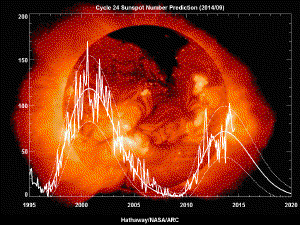Post
Wake Up Sunshine
1 October 2013
We generally think of the Sun as a constant in our lives. It rises and sets regularly, and seems to be an unchanging sphere of brilliant light. In fact the Sun has a turbulent surface with prominences that fly off its surface, granules caused by convection in its upper layers, and even the appearance of slightly cooler regions known as sunspots.
Of all these features, sunspots are relatively easy to observe, and were the first evidence that the Sun is not a fixed constant. Since the early 1600s we’ve been able to make reasonably accurate counts of the number of sunspots over time. One of the most obvious patterns that appears is an oscillation in the amount of sunspot activity over a typical span of 11 years. This is known as the 11-year cycle due to its average rate, though the cycle is sometimes longer or shorter. There are other patterns as well, such as the Gleisberg Cycle, which lasts 80 – 90 years.
Sunspot cycles also have variations that don’t follow the pattern. During the period from 1645 to 1715 there was very little sunspot activity at all, known as the Maunder minimum. From about 1790 to 1830 there was a period when the oscillations were smaller, and the periods of maximum sunspot activity were less intense, known as the Dalton minimum. We’re not entirely sure why such minimums occur, but it is clear that sunspot activity can be quite varied.
 David Hathaway
David HathawayRecently there has been a lot of talk of the strange lack of sunspot activity at a time when sunspots should be pretty active. You can see this in the image here, which plots sunspot counts (the jagged line) compared to the prediction range (the curves) for the current period known as cycle 24. You can see that this maximum is about half what the last one was. This is a bit unusual, but it isn’t “puzzling scientists” as some articles have said. This kind of variability happens from time to time.
One thing that has been noticed is that cycle 24 has some similarity to the early stages of Dalton minimum. Before the Dalton minimum, cycles got successively smaller, with the same drop to about half the activity that had been typical. If we follow a similar pattern, then cycle 25 will be about the same as cycle 24, and we will have a several decades period of a relatively quiet Sun.
Because of this you may also hear talk about global cooling and the like in the popular press. The reason is that sunspot activity (or lack thereof) has a demonstrated connection to winter temperatures. During the Maunder minimum, Europe was in the middle of what is known as the “little ice age” when they experienced very cold winters. During the Dalton minimum European winters were about a degree celsius cooler than typical, including the “year without a summer” in 1816 (though that was largely due to the Tambora eruption in 1815).
If we are entering a Dalton-like minimum, then we can expect winter temperatures be slightly cooler than recent years. However this will not be an indication of an end to the global warming trend. A sunspot minimum could help to ease off the accelerator of rising temperatures, but it won’t stop the rise or reverse it. The Dalton minimum was followed by cycles of average to high activity, so after a few decades we’d be right back where we started.
It will be a few years before we are sure if the Sun is really in a minimum, or if cycle 24 is just an unusual fluke. Either way, we know eventually the Sun will wake up.